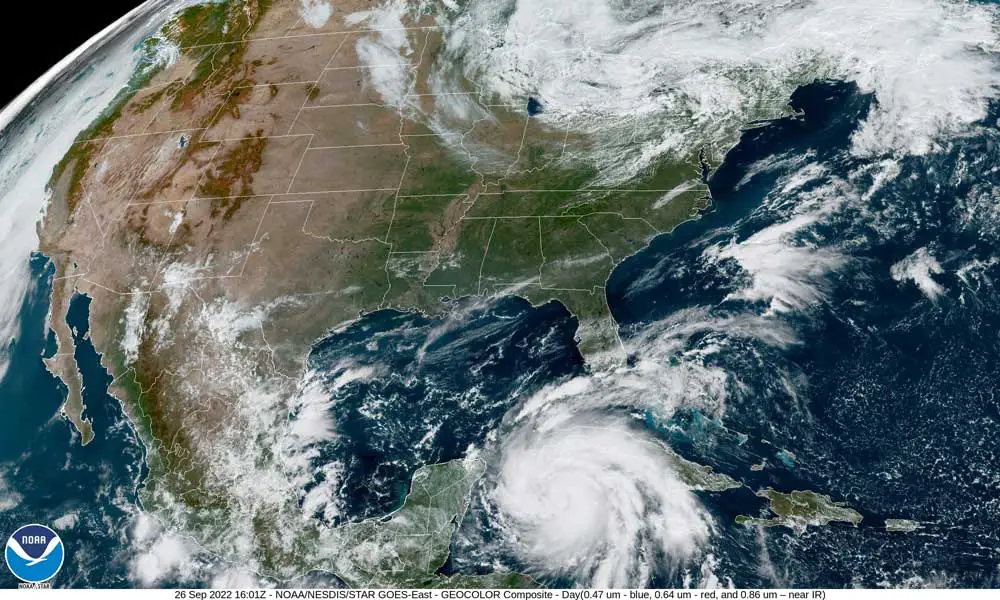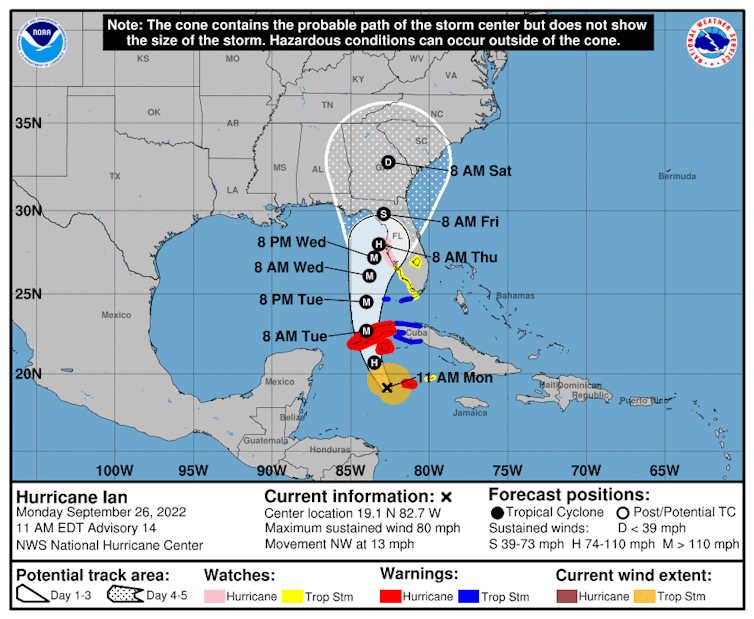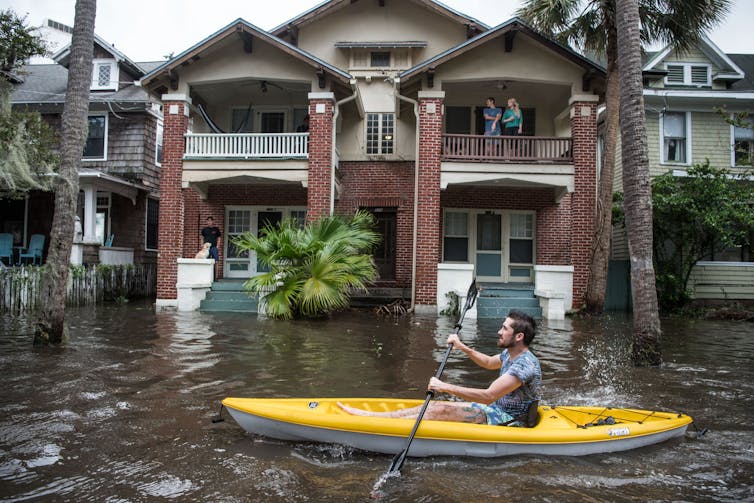
By Athena Masson
Hurricane Ian strengthened as it headed for Florida and was on track to bring a powerful storm surge and potentially flooding rainfall to most of the state this week.
After a slow start to the 2022 Atlantic hurricane season, Ian has ideal conditions. It faces minimal vertical wind shear – the difference in wind speeds and directions at different heights that can tear apart a storm. And the Caribbean Sea and Gulf surface waters are warm, providing fuel for the storm.

National Hurricane Center
Forecasters expect Ian to reach major hurricane status – Category 3 or higher on the Saffir-Simpson Hurricane Wind Scale, meaning winds over 110 mph – likely before crossing western Cuba on Tuesday. Its winds could weaken before landfall in the U.S., but the scale doesn’t take water risk into account, and flooding and storm surge are both major risks from Ian.
As a meteorologist living in Florida, I study tropical storms and hurricanes. Here are three reasons Florida’s Gulf Coast is facing a high risk of water hazards this week.
The rainy side of the storm
Tropical systems are not perfectly symmetrical systems – one side is typically larger. With Ian tracking up the west coast of Florida, the peninsula is expected to be on the “wet” side of the storm. The part of the storm east of the center of circulation generally has more cloud cover and more rain.
While Ian travels up the Florida coast, these outer bands will stretch over much of the peninsula and produce heavy rain for many locations, beginning as early as Monday night for South Florida and late Wednesday for northern parts of the state.
Some weather models are forecasting 10 inches or more of rain in the region where the storm makes landfall, possibly as high as 15 inches, while other regions could see 4 inches or more.
Regardless of the landfall location, most of the Florida Peninsula will see effects from Hurricane Ian.
Storm surge risk
As Hurricane Ian continues to track north, it will be pushing the waters of the Gulf of Mexico northward with it. This is storm surge, and it raises the water level, with waves on top adding to its destructive power.
The Gulf acts like a huge bathtub, and when strong storms enter into this region, they help lift up the water due to low barometric pressure. Barometric pressure has a direct influence on sea levels. When air pressure rises, sea levels lower. However, lower barometric pressure lifts the sea.
Additionally, the storm’s strong winds will push the water in the same direction the storm is heading. Since land surrounds the Gulf of Mexico, there is nowhere for this water to go but inland.

Sean Rayford/Getty Images
Up to 3 feet of storm surge is expected for the Florida Keys and South Florida, but these amounts could be higher, especially as Ian strengthens into a major hurricane. Locations along the western Gulf Coast could see storm surge heights between 4 and 10 feet, depending on just how close Ian tracks to the coastline.
Due to Ian’s northward track, portions of the Big Bend and the Panhandle can expect to see some storm surge and coastal flooding, especially as the storm nears land, as well as areas along the coast. The Tampa Bay area in particular should be monitoring Ian closely, especially if the center of circulation makes a direct impact or if it remains just offshore.
Size matters
Another factor to watch is Ian’s size. Size plays a key role in a hurricane’s impact.
A large hurricane, like Irma in 2017, will have more cloud cover and therefore more rain. Storm surge will reach a larger area with larger storms. If the storm is large enough, it could even generate storm surge on the eastern side of the Florida Peninsula, like Irma did along portions of northeast Florida.
A smaller storm, like Hurricane Andrew in 1992, is more of a wind storm and the impacts are in a smaller area. But as Florida saw with Andrew, wind damage can be catastrophic in these smaller systems.
It’s too early to tell how large Ian will get, but the storm is expected to intensify over the Gulf of Mexico. Residents across Florida need to prepare for the risk of heavy rain, flash flooding, storm surge, isolated tornadoes and potentially strong winds.
![]()
Athena Masson is an Adjunct professor at Flagler College.




























Timothy Patrick Welch says
Good info…Thanks
Jimbo99 says
Also going to be on the dirty side of the storm, the right hand & top, highest winds and whatever else. It’s basically a big, slower tornado. Ever since Jim Cantore retired, I think tropical storm/hurricane coverage has suffered. It’s been a good decade or so since I was in Miami when he showed up for televised storm coverage. Oh well, same principles.
The worst of Miami for me was a bout a week without power for Hurricane Wilma that came across from the Westcoast of FL. I was in an apartment that had concrete buildings to the west of me. I was blocked completely like I was in a bunker. The wind was non-existent for the apartment I was in because of the buildings. Where I am here in Flagler, I have taller houses to the South, West & East, also a tree line that might be far enough that even broken branches may not hit the house. Concrete block structures should protect. Maybe roof is the highest risk exposure. I slept thru Wilma, it hit at dawn/sunrise and was gone by noon-ish. Where the wind was hurricane force was in between the buildings, those were like focused wind tunnels.
I thought about evacuating, now is the time to do that, because we all know it’ll be gridlock traffic & fuel shortages for everyone trying to leave the day before. Trying to think of the name of the I-4 Hurricanes that went from Tampa to Daytona Beach ? That seems like those were 15+ years ago ? We all have to make that call for ourselves though. I won’t downplay the severity this hurricane could hit Flagler County with. My deal with the almighty is nothing catastrophic. But who knows for this or future storms.